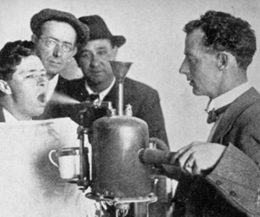
Citizens were advised to go to special inhalation chambers
The Health Department was quick of the mark with advice for those who felt they were getting the flu. They recommended that sufferers should:
- go to bed as soon as they felt pain in the limbs or head, or got a cold;
- go to bed in an unoccupied room and stay there until the temperature abates;
- take any drink, as hot as possible, and remove the sheets, lying between blankets;
- take a light diet (soups, gruel);
- “Don’t depress yourself by looking on the bad side. Remember, the large proportion of people who take ill get well”;
- allow only one family member to visit the room;
- not allow people to linger in your room;
- take ammoniated quinine in plenty of water every four hours if no doctor had seen them;
- “Add one teaspoon of boric acid or borax, one teaspoon of baking soda, and one teaspoon of salt to a large tumbler full of hot water. Sniff up this solution as hot as can be easily borne through the nose; then gargle your throat with solution as hot as can be borne. Brush your teeth with the same solution or any anti-septic toothpaste. Do all these three times a day;”
- put a handkerchief in front of their mouth when coughing or sneezing;
- keep in bed until well again;
- don’t go outdoors if you have a head cold until it has completely disappeared;
- “don’t worry, dint wirry, be cheery”
The Masterton Borough Council initiated inhalation chambers in their offices. Citizens were urged to “immunise” themselves at least once a day. Formalin was the first chemical used but it was quickly realised that this irritated the membranes in the nose and throat. It would make the patient more prone to infection from the disease, so a switch was made to a less aggressive protectant, zinc sulphate.
The inhalation chambers offered no protection against the disease and by congregating people in confined spaces might actually have helped the spread of the disease.
The Wairarapa Daily Times suggested a simple method of providing fumigation for householders. It involved taking half a shovel of glowing embers from the fire (wood not coal) and sprinkling them with three or four teaspoons of Jeyes’ Fluid. The resulting steam was to be inhaled deeply, the process being repeated daily.
An urgent message was published that sheep dip should not be used for vaporising as it contained arsenic and could poison those seeking to protect themselves.
In order to cope with the public health aspects of the disease many businesses closed and the Government shut all schools until the beginning of the new school year in 1919. Maori, who were being badly hit by the pandemic, were instructed not to hold tangi, as these social occasions also spread the virus. Other regulations were brought in making it an offence for anyone with the virus to be in a public place.
